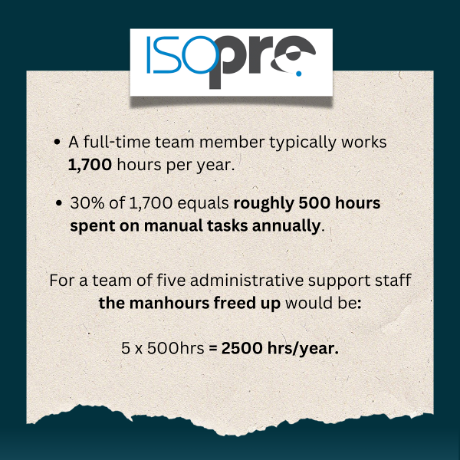Many businesses in Australia still view compliance as a cost rather than a function that can drive productivity. Outdated approaches to compliance, relying on manual processes, strengthen this view.
In Australia, many team members responsible for managing compliance often feel overwhelmed as they juggle multiple tasks while striving to stay accountable. Organisations that manage their compliance predominantly manually, or run multiple software systems for that, face very real efficiency challenges.
The reality is that manual and non-integrated compliance management significantly reduces efficiency by drawing scarce manpower into non-productive activities. To illustrate this, we’ve created a simple yet practical example to highlight the impact of manual operations on compliance management.
Experience and feedback from clients shows that in organisations managing GRC manually, employees spend an average of about 1/3 of their time on tasks that can be automated (many of them, easily so), such as tracking actions, finalising incomplete checklists, sending reminders and generating reports.
Let’s break down what this could mean for a business. To keep it simple, we’ll use a rounded estimate of 30%.
Feel free to adjust this figure based on what you believe is accurate for your team—either way, the results are bound to surprise you!

An integrated compliance software enables you significantly reduce manual tasks and save hundreds of man-hours by:
Collect information at the place of work
Mobile devices have reduced in cost tremendously and they are no longer the “wow” hardware they used to be. Deploying a data capture device at the place of work distributes data collection effort, speeds it up massively and ensures nothing is “lost in translation”. Smart forms with mandatory checks and workflow logic ensure that all the required information is collected without errors. A smart solution can also remind team members that information needs to be provided, updated or completed.Automated collation and distribution of information
An integrated compliance software enables you to automatically collect, organise, and store data within a centralised system, eliminating the need for scattered spreadsheets or data capture tools that are not integrated. This ensures all the relevant stakeholders have access to their critical information in real time.Tracking for effectiveness
Tracking actions or issues that arise from the compliance controls can take a lot of manual effort. People need to be reminded and the missing information collated and inserted into the originally collated data sets. Automated tracking via system reminders and escalations free up time and remove frustration so you and your team can concentrate on other activities. It can also strengthen responsibility and accountability at the correct operational level further improving effectiveness and reducing manual operations on compliance management.Eliminating manual reporting
A seamlessly integrated compliance software allows you to automate the creation of alerts and reports, saving hours of work. Automating the distribution of reports, or having them downloadable ‘on demand’ by relevant stakeholders, not only boosts efficiency and saves time but also reduces data collation errors and delays and improves completeness. Automating alerts also ensures all stakeholders receive necessary information, without “loss in translation”, in real time.We have case studies and references showing that, with ISOPro, organisations have reduced manual compliance administration by up to 40%. With ISOPro many of our clients have:
What could your business achieve with 30% more team capacity—without hiring extra staff?
Let’s discuss how ISOPro can help you do more in the same number of hours. Get in touch today!

Co-Founder / CEO